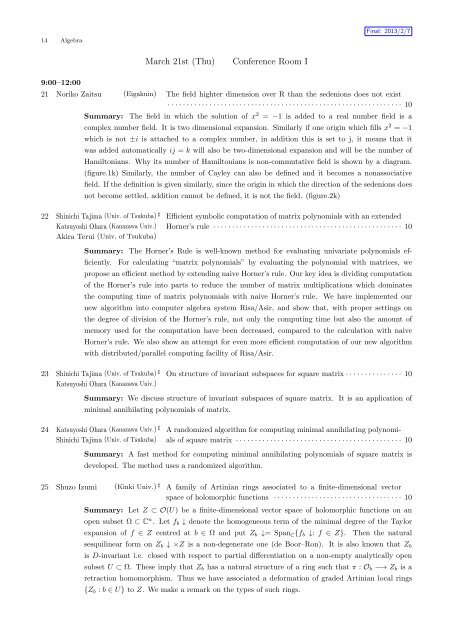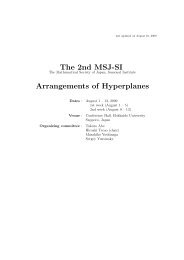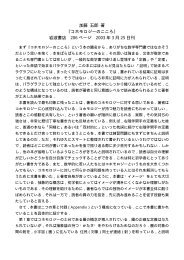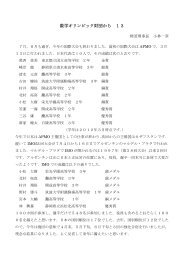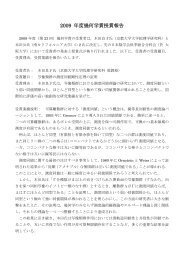Titles and Short Summaries of the Talks
Titles and Short Summaries of the Talks
Titles and Short Summaries of the Talks
Create successful ePaper yourself
Turn your PDF publications into a flip-book with our unique Google optimized e-Paper software.
14 Algebra<br />
9:00–12:00<br />
March 21st (Thu) Conference Room I<br />
Final: 2013/2/7<br />
21 Noriko Zaitsu (Eigakuin) The field highter dimension over R than <strong>the</strong> sedenions does not exist<br />
· · · · · · · · · · · · · · · · · · · · · · · · · · · · · · · · · · · · · · · · · · · · · · · · · · · · · · · · · · · · · · 10<br />
Summary: The field in which <strong>the</strong> solution <strong>of</strong> x 2 = −1 is added to a real number field is a<br />
complex number field. It is two dimensional expansion. Similarly if one origin which fills x 2 = −1<br />
which is not ±i is attached to a complex number, in addition this is set to j, it means that it<br />
was added automatically ij = k will also be two-dimensional expansion <strong>and</strong> will be <strong>the</strong> number <strong>of</strong><br />
Hamiltonians. Why its number <strong>of</strong> Hamiltonians is non-commutative field is shown by a diagram.<br />
(figure.1k) Similarly, <strong>the</strong> number <strong>of</strong> Cayley can also be defined <strong>and</strong> it becomes a nonassociative<br />
field. If <strong>the</strong> definition is given similarly, since <strong>the</strong> origin in which <strong>the</strong> direction <strong>of</strong> <strong>the</strong> sedenions does<br />
not become settled, addition cannot be defined, it is not <strong>the</strong> field. (figure.2k)<br />
22 Shinichi Tajima (Univ. <strong>of</strong> Tsukuba) ♯ Efficient symbolic computation <strong>of</strong> matrix polynomials with an extended<br />
Katsuyoshi Ohara (Kanazawa Univ.)<br />
Akira Terui (Univ. <strong>of</strong> Tsukuba)<br />
Horner’s rule · · · · · · · · · · · · · · · · · · · · · · · · · · · · · · · · · · · · · · · · · · · · · · · · · · 10<br />
Summary: The Horner’s Rule is well-known method for evaluating univariate polynomials ef-<br />
ficiently. For calculating “matrix polynomials” by evaluating <strong>the</strong> polynomial with matrices, we<br />
propose an efficient method by extending naive Horner’s rule. Our key idea is dividing computation<br />
<strong>of</strong> <strong>the</strong> Horner’s rule into parts to reduce <strong>the</strong> number <strong>of</strong> matrix multiplications which dominates<br />
<strong>the</strong> computing time <strong>of</strong> matrix polynomials with naive Horner’s rule. We have implemented our<br />
new algorithm into computer algebra system Risa/Asir, <strong>and</strong> show that, with proper settings on<br />
<strong>the</strong> degree <strong>of</strong> division <strong>of</strong> <strong>the</strong> Horner’s rule, not only <strong>the</strong> computing time but also <strong>the</strong> amount <strong>of</strong><br />
memory used for <strong>the</strong> computation have been decreased, compared to <strong>the</strong> calculation with naive<br />
Horner’s rule. We also show an attempt for even more efficient computation <strong>of</strong> our new algorithm<br />
with distributed/parallel computing facility <strong>of</strong> Risa/Asir.<br />
23 Shinichi Tajima (Univ. <strong>of</strong> Tsukuba) ♯<br />
Katsuyoshi Ohara (Kanazawa Univ.)<br />
On structure <strong>of</strong> invariant subspaces for square matrix · · · · · · · · · · · · · · · 10<br />
Summary: We discuss structure <strong>of</strong> invariant subspaces <strong>of</strong> square matrix. It is an application <strong>of</strong><br />
minimal annihilating polynomials <strong>of</strong> matrix.<br />
24 Katsuyoshi Ohara (Kanazawa Univ.) ♯ A r<strong>and</strong>omized algorithm for computing minimal annihilating polynomi-<br />
Shinichi Tajima (Univ. <strong>of</strong> Tsukuba) als <strong>of</strong> square matrix · · · · · · · · · · · · · · · · · · · · · · · · · · · · · · · · · · · · · · · · · · · · 10<br />
Summary: A fast method for computing minimal annihilating polynomials <strong>of</strong> square matrix is<br />
developed. The method uses a r<strong>and</strong>omized algorithm.<br />
25 Shuzo Izumi (Kinki Univ.) ♯ A family <strong>of</strong> Artinian rings associated to a finite-dimensional vector<br />
space <strong>of</strong> holomorphic functions · · · · · · · · · · · · · · · · · · · · · · · · · · · · · · · · · · 10<br />
Summary: Let Z ⊂ O(U) be a finite-dimensional vector space <strong>of</strong> holomorphic functions on an<br />
open subset Ω ⊂ C n . Let fb ↓ denote <strong>the</strong> homogeneous term <strong>of</strong> <strong>the</strong> minimal degree <strong>of</strong> <strong>the</strong> Taylor<br />
expansion <strong>of</strong> f ∈ Z centred at b ∈ Ω <strong>and</strong> put Zb ↓= Span C{fb ↓: f ∈ Z}. Then <strong>the</strong> natural<br />
sesquilinear form on Zb ↓ ×Z is a non-degenerate one (de Boor–Ron). It is also known that Zb<br />
is D-invariant i.e. closed with respect to partial differentiation on a non-empty analytically open<br />
subset U ⊂ Ω. These imply that Zb has a natural structure <strong>of</strong> a ring such that π : Ob −→ Zb is a<br />
retraction homomorphism. Thus we have associated a deformation <strong>of</strong> graded Artinian local rings<br />
{Zb : b ∈ U} to Z. We make a remark on <strong>the</strong> types <strong>of</strong> such rings.


